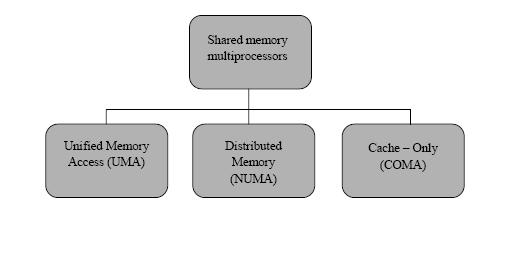CSC/ECE 506 Spring 2010/ch 6 PP
CACHE STRUCTURES OF MULTI-CORE ARCHITECTURES
Overview
With the advent of multicore and many core architectures, we are facing a problem that is relatively new to parallel computing, namely, the management of hierarchical parallel caches. This chapter describes some of the mainstream memory organizations in multiprocessor architectures. It also focuses on cache coherence and memory consistency issues and protocols to handle them.
Shared Memory Multiprocessors
Scalable shared-memory multiprocessors are emerging as attractive platforms for applications with high-performance demands. What makes these machines attractive is the shared address space, which allows processors in a multiprocessor to share data the same way it is shared by multiple processes in a sequential machine. The shared-memory paradigm makes it easier to write parallel programs, but tuning the application to reduce the impact of frequent long-latency memory accesses still requires substantial programmer effort.
From the perspective of system architecture, current mainstream shared memory multiprocessors fall into three categories as shown in Figure 1 :
UMA(Unified Memory Access), NUMA (Non-Uniform Memory Access) and COMA (Cache-only Memory Architectures).
Figure 1: Shared Memory Multiprocessors
UMA-Uniform Memory Access
All the processors in the UMA model share the physical memory uniformly. In a UMA architecture, access time to a memory location is independent of which processor makes the request or which memory chip contains the transferred data. Each processor may use a private cache. Peripherals are also shared in some fashion; The UMA model is suitable for general purpose and time sharing applications by multiple users. It can be used to speed up the execution of a single large program in time critical applications.
Figure 2: UMA-Uniform Memory Access
SMP is a common UMA architecture, in which multiple processors are connected on the system memory symmetrically and access the system memory equally and uniformly. Since all processors in the SMP system share the bus and competition conflict upgrades dramatically when the number of processors increases.
Due to the performance bottleneck of the system bus, current SMP system usually has only tens of processors with limited scalability. This architecture provides almost identical memory access latencies for any processor. But on the other hand, a common system bus is a potential bottleneck of the entire memory system in terms of bandwidth. Indeed, if a multi-threaded application is critical to memory bandwidth, its performance will be limited by this memory organization.
NUMA (Non-Uniform Memory Access)
NUMA is specialized memory architecture for multiprocessor based systems where a set of CPUs on one system memory bus is fixed and other sets of CPUs are on different memory buses and the various processing nodes are connected by means of a high speed connection. This architecture is in contrast SMP where all memory access is shared through a single memory bus.The whole system logically divides into multiple nodes, which can access both local and remote memory resources. It is faster to access local memory than access remote memory. This is the reason for the name, non-uniform memory access architecture.
Consider Figure 3. Each group of processors has its own memory and possibly its own I/O channels, but each CPU can access memory associated with other groups in a coherent way. Each group is called a NUMA node. The number of CPUs within a NUMA node depends on the hardware vendor.
In a node, the processors share a common memory space or “local” memory. For example, an SMP system’s shared memory would make up a node. This memory, of course, provides the fastest non-cache memory access for the node’s CPU. Multiple nodes are then combined together to form a NUMA machine. Memory transfers between nodes are handled by routers. Memory that can only be accessed via a router is called ‘remote’ memory.

